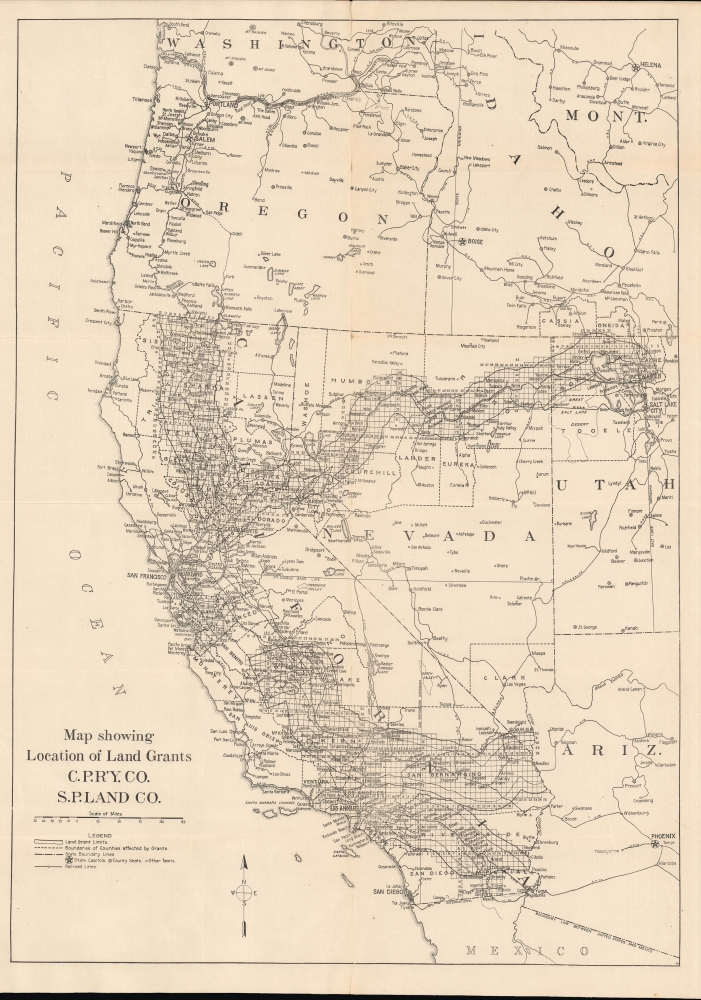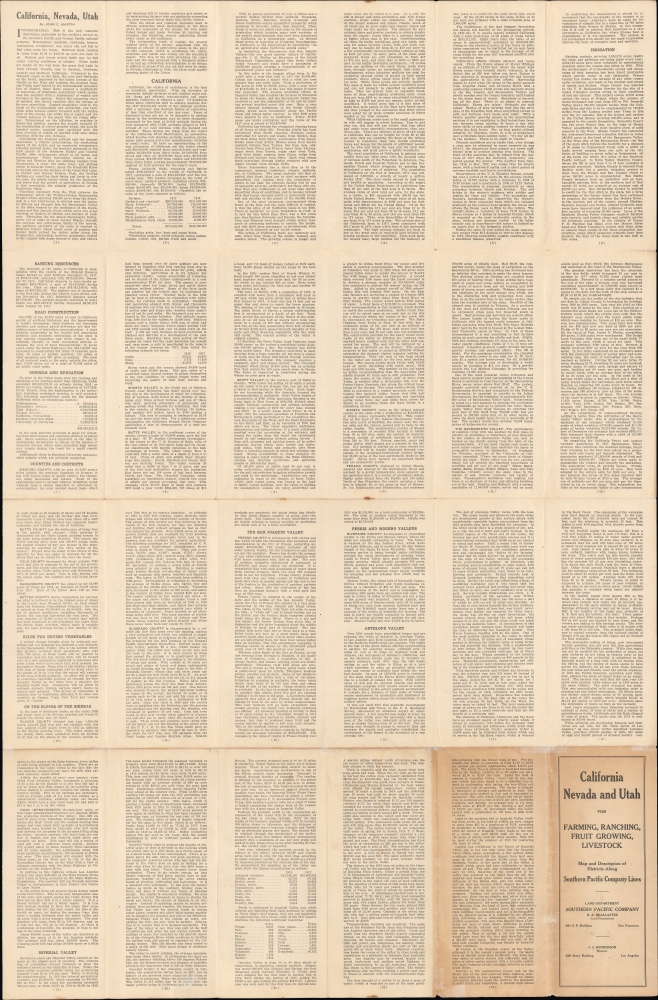1918 Southern Pacific Map of Land Grants in the Western United States
LandGrants-southernpacific-1918$450.00

Title
Map showing Location of Land Grants C.P.R'Y.CO. S.P.Land CO. / California, Nevada and Utah for farming, ranching, fruit growing, livestock...
1918 (undated) 23 x 16.5 in (58.42 x 41.91 cm) 1 : 3150000
1918 (undated) 23 x 16.5 in (58.42 x 41.91 cm) 1 : 3150000
Description
A rare and absorbing c. 1918 work, this map and pamphlet covering the Western United States reflects the reach and power of the Southern Pacific Railroad in the early 20th century. It promotes the settlement of remaining land grants held by the railroad, including in the San Joaquin, Antelope, and Imperial Valleys in California.
The Southern Pacific Land Company. was created as a subsidiary of the railroad in the late 19th century to manage, often to sell, the railroad's remaining property. Over the following decades, more and more of the railroad's lands were transferred to the Land Company. These remaining lands were less desirable than grants that had already been sold off, and, as this pamphlet indicates, the railroad heavily promoted settlement in the San Joaquin, Antelope, and Imperial Valleys in California. These valleys had historically been too arid or lacked a consistent water supply suitable for farming but were made arable by irrigation projects in the late 19th century, resulting in an influx of settlers.
An increasingly important asset for the railroad at this time was also oil reserves lying under its lands; at the time of publication, the Southern Pacific Land Co. owned more than 19 percent of all proven oil land in California. Already by the 1890s, Collis Huntington, one of the 'Big Four' who owned the Southern Pacific, estimated that the oil-producing land owned by the railroad far exceeded the value of all its other assets. In 1921, soon after this map's publication, the oil-producing land was spun off into its own subsidiary, the Pacific Oil Company, which was sold to the Tide Water Associated Oil Company in 1926.
A Closer Look
The map covers the Western United States, focusing on California, Nevada, and Utah, with Oregon and portions of Arizona, Idaho, Washington, Montana, and northern Mexico also included. Grid lines mark out the land grants given by the U.S. Congress in the late 19th century to railroad companies, namely the Southern Pacific and the Central Pacific (owned, from 1885, by the Southern Pacific). As can be seen here, these grants constituted millions of acres of land. In addition to the rail lines and land grants, cities and towns, county lines, surveying lines (meridians), and geographic features such as lakes and rivers are noted throughout. Promotional text on the recto and verso describes various key land grants, economic projects and plans therein, and the benefits of settlement.Railroads and Land Grants
Railroad land grants were a major government initiative in the mid-19th century designed to promote the construction of railroads and the settlement of the American West. Though much celebrated upon their completion, the economic logic for transcontinental railroads was scant, whereas the political and military logic for them was manifest. As a result, through a series of laws, the federal government (as well as territorial and state governments) provided an inducement to railroads by granting them tracts of land alongside the lines, in essence guaranteeing them future revenue as stations, towns, and farms cropped up along the rail lines. In order to provide some limitations on the future power of railroads, Congress instituted a 'checkerboard pattern' whereby the land grants were divided into equally sized blocks, with alternating blocks granted to the railroad or being retained by the government for future use, usually to be given to homesteaders. Although this system worked to quickly construct transcontinental and other long-distance railroads in the American West, the process was marred by widespread corruption, mismanagement by the railroads, and the displacement of Native Americans, including the violation of existing treaty terms to provide land grants to railroads.Southern Pacific Land Co.
The management of granted land was a vital part of the operation and profitability of railroads, and, as one of the largest railroads in the American West, the Southern Pacific was no exception. In fact, the Southern Pacific Railroad was originally founded as a land-holding company aimed at connecting San Francisco with Los Angeles and San Diego by rail and, more importantly, to own the lands in between. The company was quickly acquired by the 'Big Four' railroad entrepreneurs of California who had launched the Central Pacific Railroad (the western half of the first transcontinental railroad).The Southern Pacific Land Company. was created as a subsidiary of the railroad in the late 19th century to manage, often to sell, the railroad's remaining property. Over the following decades, more and more of the railroad's lands were transferred to the Land Company. These remaining lands were less desirable than grants that had already been sold off, and, as this pamphlet indicates, the railroad heavily promoted settlement in the San Joaquin, Antelope, and Imperial Valleys in California. These valleys had historically been too arid or lacked a consistent water supply suitable for farming but were made arable by irrigation projects in the late 19th century, resulting in an influx of settlers.
An increasingly important asset for the railroad at this time was also oil reserves lying under its lands; at the time of publication, the Southern Pacific Land Co. owned more than 19 percent of all proven oil land in California. Already by the 1890s, Collis Huntington, one of the 'Big Four' who owned the Southern Pacific, estimated that the oil-producing land owned by the railroad far exceeded the value of all its other assets. In 1921, soon after this map's publication, the oil-producing land was spun off into its own subsidiary, the Pacific Oil Company, which was sold to the Tide Water Associated Oil Company in 1926.
Publication History and Census
This map was produced by the Land Department of the Southern Pacific Railroad (with the cartographer's initials, perhaps 'F.M.,' written in small letters in the bottom-right corner). It is undated, but the promotional text discusses projects in 1917, suggesting a publication date soon afterward. No mention is made of railroad nationalization, which was undertaken in 1917 to support the war effort. However, that is likely because nationalization applied to the railroads' lines and equipment (rolling stock, etc.) rather than additional assets like land. The only known institutional holding of this map is with the University of California, Davis, which suggests a date of 1918. We are unaware of any other examples in institutional collections or on the market.Condition
Very good. Closed margin tear professionally repaired on verso. Verso repairs to fold separations. Slight loss at fold intersection, only one of which effects the map. Dimensions are for map not the entire sheet.
References
OCLC 497227676. White, R., Railroaded: The Transcontinentals And The Making Of Modern America (W. W. Norton, 2012). Daggett, S., Chapters on the History of the Southern Pacific (New York: The Ronald Press Company, 1922).








